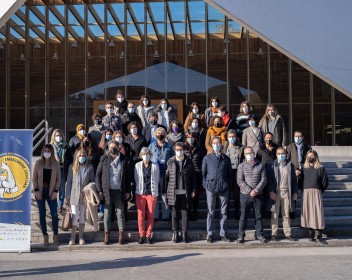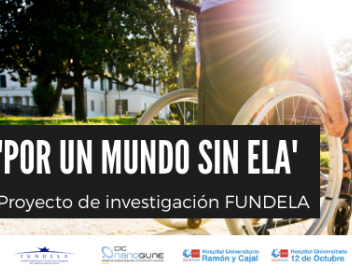Noticias
La ciencia sí es cosa de chicas
Diecisiete entidades vascas han presentado esta mañana el proyecto Emakumeak Zientzian que va adquiriendo mayor dimensión con el paso de los años, ratificando así su compromiso con los objetivos de la iniciativa: hacer visible la actividad de las mujeres en ciencia, romper con los roles típicamente masculinos atribuidos a las actividades científico-técnicas, y fomentar la elección de carreras científicas entre niñas y adolescentes. Con estos objetivos en mente, las entidades suman fuerzas para preparar un programa de actividades conjunto con motivo del Día Internacional de la Mujer y la Niña en la Ciencia, que se celebra cada año el 11 de febrero.
NanoGUNE, el gran reto de lo pequeño, también en castellano e inglés
CIC nanoGUNE presentó hace casi un año el libro “NanoGUNE txikiaren xarma” que recoge la creación y desarrollo del centro de investigación desde sus inicios. Tras su esplendida acogida, ahora el libro ha sido traducido al castellano (NanoGUNE, el encanto de lo pequeño) y al inglés (NanoGUNE, the charm of the small) y está disponible para todo el público.
CIC nanoGUNE abre el plazo de inscripción del programa de prácticas de verano
CIC nanoGUNE ampliará sus instalaciones de microscopía electrónica con un instrumento FIB único
El Ministerio de Ciencia e Innovación del Gobierno de España ha concedido 1,5 millones de euros a nanoGUNE con el objetivo de traer principalmente nuevas tecnologías FIB o tecnologías de Haz de Iones Focalizados al País Vasco (FIB, Focused Ion Beams). El equipo estará compuesto de un microscopio electrónico de haz de iones focalizado de última generación, que combinará características que normalmente no están presentes juntas en un solo instrumento: un amplio conjunto de detectores para aplicaciones del ámbito de la ciencia de los materiales; la opción de extracción de gran volumen dirigida al sector de las baterías y la industria; y una opción de crio típicamente dedicada a aplicaciones biológicas. Esta combinación de características en un solo instrumento será única en Europa y también proporcionará nuevas oportunidades de investigación en la ciencia de los materiales relacionada con la física de baja temperatura y en las ciencias biológicas relacionadas con la tomografía de criocélulas. Este instrumento será la base de una instalación de investigación común, una de las pocas que existen en Europa.
CIC nanoGUNE obtiene un proyecto para investigar la esclerosis lateral amiotrófica (ELA)
La Fundación Española para el Fomento de la Investigación de la Esclerosis Lateral Amiotrófica (FUNDELA) concede un proyecto para investigación sobre esclerosis lateral amiotrófica (ELA) a CIC nanoGUNE, en colaboración con el Laboratorio de Investigación en ELA del Hospital 12 de Octubre - “i+12” y el Servicio de Genética del Hospital Ramón y Cajal-IRYCIS pertenecientes al Centro de Investigación Biomédica en Red de Enfermedades Raras (CIBERER).
El gigante brasileño JBS invierte 36 millones en el productor vasco de carne cultivada Biotech Foods
Emilio Artacho APS Fellowship in 2021
Emakumeak Zientzian sigue sumando
Diecisiete entidades vascas unen fuerzas en torno al proyecto Emakumeak Zientzian a través de la firma de un nuevo acuerdo de colaboración, ratificando así su compromiso con los objetivos de la iniciativa: hacer visible la actividad de las mujeres en ciencia, romper con los roles típicamente masculinos atribuidos a las actividades científico-técnicas, y fomentar la elección de carreras científicas entre niñas y adolescentes. Con estos objetivos en mente, las entidades suman fuerzas para la organización de un programa de actividades conjunto con motivo del Día Internacional de la Mujer y la Niña en la Ciencia, que se celebra cada año el 11 de febrero.
Overriding Universality via nano-scale Materials Design
In a recent article published in Physical Review Letters (Phys. Rev. Lett. 127, 147201 (2021)), researchers from the Nanomagnetism group at nanoGUNE in collaboration with scientists from the US and Colombia have demonstrated that it is possible to design thermodynamic critical exponents a la carte and override the universality of phase transition behavior, which was previously understood to be only dependent on the dimensionality of sample and order parameter.
Researchers develop an innovative strategy to focus infrared light into the nanoscale
An international team of researchers, including members of nanoGUNE's Nanooptics group, publish in “Science Advances” the grounds for the realization of nanodevices that, based on the manipulation of light at the nanoscale, promise the development of extraordinarily sensitive biosensors. The researchers also designed gold nanoantennas that allow obtaining extremely small (600.000 times smaller than the size of a grain of sugar) and bright focal spots. This achievement opens new avenues for the detection and control of single molecules, such as glucose, and atmospheric contaminants.
Agenda
| Lun | Mar | Mié | Jue | Vie | Sáb | Dom |
|---|---|---|---|---|---|---|
|
24
|
25
|
26
|
27
|
28
|
1
|
2
|
|
|
|
|
|
|
|
|
|
3
|
4
|
5
|
6
|
7
|
8
|
9
|
|
|
|
|
|
|
|
|
|
10
|
11
|
12
|
13
|
14
|
15
|
16
|
|
|
|
|
|
|
|
|
|
17
|
18
|
19
|
20
|
21
|
22
|
23
|
|
|
|
|
|
|
|
|
|
24
|
25
|
26
|
27
|
29
|
30
|
|
|
|
|
|
|
|
|
|
|
1
|
2
|
3
|
4
|
5
|
6
|
|
|
|
|
|
|
|
|
Eventos
- 31/03/2025 al 04/04/2025
Spin & Orbit
nanoTECA
Encuentra fotos, imágenes experimentales, vídeos, audios y elementos de la imagen corporativa de nanoGUNE.











